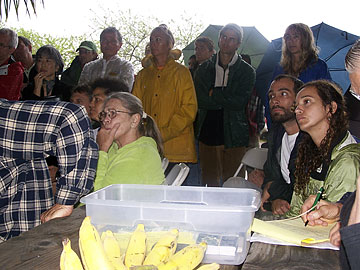NO REST FOR WEATHER-WEARY ON KAUAI

PHOTO COURTESY OF CARL WRIGHT
Farmers gathered in Kilauea yesterday to discuss the fate of Ka Loko Dam. The 20 or so affected say losing irrigation water from the reservoir will kill their farms.
|
|
Farmers say they need reservoirs restored
Dozens will go out of business if they lose their water source, lawmakers are told
KILAUEA FARMS, Kauai » Tuesday's Ka Loko Dam disaster may also eventually destroy more than a dozen farms and much of the organic produce on the north shore, government officials learned yesterday.
At least 20 farmers growing everything from organic papaya and citrus fruits to lettuce and herbs used Ka Loko Reservoir as their source for irrigation water, and another handful used the Morita Reservoir for their crops.
While dam experts from California and the University of Hawaii have told state officials the reservoirs' dams are unsafe, the farmers say that if the state destroys the reservoirs, it may as well bulldoze the farms, too.
"My life will be ruined without that ag water," said Rosa Russell, who operates an organic farm that receives water from Ka Loko. "Without that water, my trees will die."
About 50 people huddled into fellow organic farmer Phil Green's barn, surrounded by ginger. As a raging thunderstorm dumped rain on the roof, they described for representatives from the county, state and federal governments the impacts if the reservoirs are destroyed.
All farmers agreed that the county water system is already taxed in the Kilauea area, and that costs and water pressure are so prohibitive their only choice is the reservoirs above Kilauea, including Morita and Ka Loko.
There's still water in Ka Loko, and Tom Hitch, owner of the Kilauea Irrigation Co., which operates and maintains the pipeline from Ka Loko to the farms, wants to reopen the irrigation to farmers when the rain stops and the crops dry out.
"It can be safe again," Hitch said. "If Ka Loko is destroyed, a lot of the farmers will go out of business."
Hitch said a smaller reservoir could be rebuilt, using the breached dam as a spillway and the existing ditch system that feeds Ka Loko.
"The two ditches are in excellent shape," he said. "The inflows are better than before," after nearby landowner James Pflueger fixed them recently.
Alan Rietow, another resident who uses Hitch's pipeline, said Ka Loko "could be the safest reservoir in the state" now that the flood plain has been identified.
State Rep. Mina Morita, who represents the area and put the meeting together, said that while the first priority is the safety of people who makai of the reservoirs, the farmers' concerns will be part of the discussion.
No decision has been made on the future of the reservoirs at this point, said Sandra Lee Kunimoto, director of the state Department of Agriculture.

